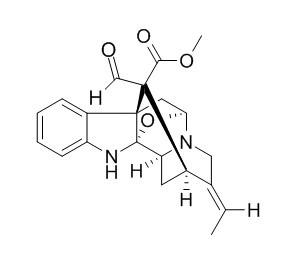Picralinal
Picralinal has anti-inflammatory and analgesic effects.
Inquire / Order:
manager@chemfaces.com
Technical Inquiries:
service@chemfaces.com
Tel:
+86-27-84237783
Fax:
+86-27-84254680
Address:
1 Building, No. 83, CheCheng Rd., Wuhan Economic and Technological Development Zone, Wuhan, Hubei 430056, PRC
Providing storage is as stated on the product vial and the vial is kept tightly sealed, the product can be stored for up to
24 months(2-8C).
Wherever possible, you should prepare and use solutions on the same day. However, if you need to make up stock solutions in advance, we recommend that you store the solution as aliquots in tightly sealed vials at -20C. Generally, these will be useable for up to two weeks. Before use, and prior to opening the vial we recommend that you allow your product to equilibrate to room temperature for at least 1 hour.
Need more advice on solubility, usage and handling? Please email to: service@chemfaces.com
The packaging of the product may have turned upside down during transportation, resulting in the natural compounds adhering to the neck or cap of the vial. take the vial out of its packaging and gently shake to let the compounds fall to the bottom of the vial. for liquid products, centrifuge at 200-500 RPM to gather the liquid at the bottom of the vial. try to avoid loss or contamination during handling.
Org Biomol Chem.2017, 15(31):6483-6492
J Food Biochem.2021, 45(7):e13774.
Acta Physiologiae Plantarum2015, 37:1736
Applied Physics B2021, 127(92).
Int J Mol Sci.2020, 21(22):8816.
Biochem Pharmacol.2020, 178:114083
Horticulturae2021, 7(1),5.
Chengdu University of Traditional Chinese Medicine2024, 4802935.
NanoBioScience2024, v13:3:115.
Biomed Pharmacother.2024, 179:117346.
Related and Featured Products
J Ethnopharmacol. 2010 May 27;129(2):174-81.
Pharmacological evaluation of Alstonia scholaris: anti-inflammatory and analgesic effects.[Pubmed:
20219658]
Alstonia scholaris (Apocynaceae) has been historically used in "dai" ethnopharmacy to treat chronic respiratory diseases. The leaf extract, developed as a commercially available traditional Chinese medicine, used to release tracheitis and cold symptom, has also been prescribed in hospitals and sold over the counter in drug stores.
The investigation evaluated the anti-inflammatory and analgesic activities of the ethanolic extract, fractions and main alkaloids of Alstonia scholaris leaf to provide experimental evidence for its traditional and modern clinical use. Besides, to discover the active fraction and components for further better use in Chinese medicine is hopeful.
METHODS AND RESULTS:
The leaf of Alstonia scholaris was extracted with ethanol and then separated into different fractions. Furthermore, alkaloids were isolated by phytochemical method. The analgesic activities were investigated using acetic acid-induced writhing, hot-plate and formalin tests in mice. The anti-inflammatory activities were carried out in vivo and in vitro, including xylene-induced ear edema and carrageenan-induced air pouch formation in mice, and COX-1, -2 and 5-LOX inhibition.
It has been exhibited that the EtOAc and alkaloid fractions reduced acetic acid-induced writhing response in mice, significantly. The ethanolic extract, EtOAc and alkaloid fractions remarkably inhibited xylene-induced ear edema. Further investigation was focused on the alkaloids fraction and three main alkaloids isolated from the alkaloids fraction, in different animal models. Alkaloids reduced acetic acid-induced writhing response, and xylene-induced ear edema in mice. In the hot-plate test, alkaloids did not increase the latency period of mice obviously. In the formalin test, alkaloids did not inhibit the licking time in first phase, but significantly inhibited the licking time in second phase of mice. Alkaloids increased significantly SOD activity and decreased levels of NO, PGE2 and MDA significantly, in air pouch mice model. Moreover, some alkaloids isolated from the leaf of Alstonia scholaris exhibited inhibition of COX-1, COX-2 and 5-LOX in vitro anti-inflammatory assay, which supported alkaloids as the bioactive fraction.
CONCLUSIONS:
The alkaloids fraction of Alstonia scholaris leaf, three main alkaloids, picrinine, vallesamine and scholaricine, may produce the anti-inflammatory and analgesic effect peripherally based on several in vivo assays. In in vitro tests, alkaloids exhibited inhibition of inflammatory mediators (COX-1, COX-2 and 5-LOX), which is accordant with results on animal models. Besides, COX-2/5-LOX dual inhibitors found in the experiment, such as 16-formyl-5alpha-methoxystrictamine, Picralinal, and tubotaiwine might be valuable for further attention.



